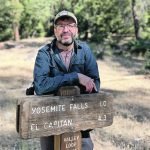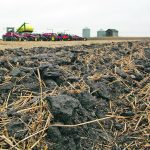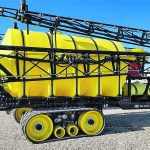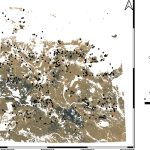Study aims to provide a baseline of soil health in Canada and inform future policies that will protect soil as a vital resource
The Senate agriculture committee took a field trip to Western Canada last month to learn more about the soil it has been studying for a year. The standing committee stopped at the Discovery Farm at Langham, Sask., and spent time with academics and students from the University of Saskatchewan’s agriculture college, before moving on to […] Read moreTag Archives Soil — page 4

Study examines how competing microbes access plants
Bacteria that demonstrate positive effects on plants in the lab often can’t compete in field conditions
The goal is to find a strain, or several strains, of bacteria that offer maximum benefit to the host crop and can successfully compete against local bacterial strains already in the soil.
Soil microbes can influence ‘forever chemicals’
Some types of chemicals can leach from fertilizers made from recycled waste with the help of microbial decomposition
The problem with forever chemicals is exactly that — they don’t go away and they persist in the environment. Now, researchers at Drexel University in Philadelphia have found that soil microbes appear to support the release of these chemicals, known as per- and polyfluoroalkyl substances (PFAS), into the environment and across croplands. “What happens is […] Read more
Hauling the QuadApplicator
The concept of ensconcing one individual seed into one big nutrient-laden liquid droplet, and keeping it safely stable and suspended until it’s sprayed out onto soil, is a mighty challenge. Hauling the apparatus around in the field is also a formidable task. Nonetheless, it is the sort of thing Bob West at R.A.West does in […] Read more

Project studies how to measure soil carbon
To get a better handle on how much carbon is stored in soil and how soil carbon is changing over time, researchers from the University of Saskatchewan, the University of Guelph and other institutions are conducting a case study at a 32,000-acre farm near Moosomin, Sask.

Ag needs to understand organic matter and production risk
A research project from Agriculture Financial Services Corporation shows that soil organic matter may be the most important factor for managing crop-insurance-related production risks. The province-wide study was conducted by Serecon Consulting and used field-level soil organic matter mapping from the Food Water Wellness Foundation. While the intent of the study was to better understand […] Read more

Three sizes for carbon capture
Canadian farmland could sequester 72.7 million tonnes of carbon if more producers adopted beneficial practices like cover crops, applying compost and reducing tillage, says a new report from the Soil Conservation Council of Canada and the Compost Council of Canada. The report, released April 5, says there are three possible scenarios for storing carbon in […] Read more

Historical space and terrestrial data predict soils’ properties
University of Saskatchewan researchers improve bare soil predictive modelling for agriculture in province
Historical soil data combined with satellite imagery is being used to create models that can accurately predict soil properties, including the most precise soil-texture map currently available in Saskatchewan. Researchers from the University of Saskatchewan already created a synthetic bare soil map with data from the Google Earth Engine (GEE) to predict soil properties. However, […] Read more
Return of the Dirty Thirties — with a vengeance
We’re all pretty confident we’ll never experience another dust bowl. So much so that it never even enters our conscious minds. Zero till, irrigation and drought-tolerant crops remove all fear of a repeat. But maybe we’re all wrong. Two researchers at the University of Chicago think so. They argue that it’s inevitable we will experience […] Read more

Laser beam focus on soil moisture
Scientists at the University of Kansas have started using a new tool to help understand how water moves, or doesn’t move, in the soil. Daniel Hirmas and his team of soil hydrologists are using a Multistripe Laser Triangulation (MLT) scanner to measure the size of pores in soil horizons. “We hand dig seven foot deep […] Read more






